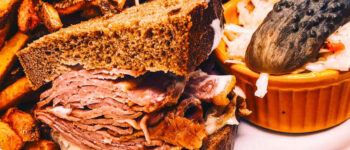If you’re a ramen lover like me, you’ve probably wondered how those mouthwatering noodles are made. Ramen noodles are not only convenient and tasty, but they also have a fascinating process behind their creation. In this article, I’ll take you on a journey through the world of ramen noodles and reveal the secrets of their deliciousness.
What’s in Ramen?
Ramen noodles are a simple delight made with just a few basic ingredients. It all starts with the noodles and the broth. These two elements are the heart and soul of any ramen dish. But what sets ramen apart from other types of noodles is the infinite possibilities of flavors and ingredients that can be added.
From rich chicken or pork broth enhanced by shiitake mushrooms to sardines in oil with onions, ramen offers a universe of flavors to explore. And let’s not forget about the beloved soy sauce, adding that perfect touch of saltiness to your bowl.
The Tradition of Japanese Ramen
Ramen noodles have a long history in Japan. They were introduced to the country by Chinese immigrants in the late 19th century. However, it wasn’t until after World War II that ramen became a popular and affordable meal for the Japanese people.
During the war, wheat was scarce, so the Japanese government started rationing it. To stretch their limited supply, they added salt and kansui (alkaline water) to the flour, creating a noodle that required less wheat. This ingenious solution allowed the Japanese to enjoy a filling and comforting meal during challenging times.
In 1958, Momofuku Ando, the founder of Nissin Foods Corporation, invented the first instant ramen noodle. This groundbreaking creation revolutionized the way people enjoyed ramen and turned it into a staple food, not only in Japan but also in other parts of Asia and the United States.
What Are Ramen Noodles Made Of?
Ramen noodles are crafted from a simple yet harmonious combination of four key ingredients: wheat flour, salt, water, and kansui. Kansui, an alkaline water, gives ramen noodles their unique firm texture and yellowish color.
The dough for ramen noodles is made by combining wheat flour and salt, while some brands may also incorporate egg into the mix. Once the dough is ready, it is rolled out into thin sheets and cut into noodles of the desired width.
How To Make Ramen Noodles
If you’ve ever wondered how to make ramen noodles from scratch, it’s simpler than you might think. To make the dough, mix wheat flour, salt, water, and kansui in a bowl. Knead the mixture until it forms a cohesive dough.
After letting the dough rest for 30 minutes, roll it out into a thin sheet. Then, use a sharp knife to cut the dough into thin strips. These fresh noodles can be cooked in boiling water for 3-5 minutes and added to your favorite broth or served with a dipping sauce.
If you want to see the process in action, check out this video on how to make ramen noodles.
The 5 Types of Ramen
Ramen is not just a one-size-fits-all dish. There are five distinct types of ramen noodles, each with its own unique broth and flavor profile:
1. Shio Ramen
Shio ramen features a clear and salty broth, typically made with chicken or seafood. The simplicity of this flavor allows the other ingredients to shine.
2. Shoyu Ramen
Shoyu ramen is made with a soy sauce-based broth, which gives it a rich and savory taste. Chicken or beef is commonly used to create the broth.
3. Miso Ramen
See more : How Long Does a Manicure Take?
Miso ramen boasts a rich and hearty broth infused with miso paste. This type of ramen is often made with chicken or pork as the base.
4. Tonkotsu Ramen
Tonkotsu ramen is known for its creamy and flavorful pork bone-based broth. Chicken or beef may also be used in combination with the pork bones.
5. Vegetarian Ramen
For those who prefer a meat-free option, vegetarian ramen is an excellent choice. It features a vegetable-based broth made with ingredients like soy milk or tofu.
5 Regional Styles of Ramen
Ramen noodles have regional variations across Japan, each with its own distinct style and flavor. Here are five notable regional styles:
1. Shinshu Ramen
Shinshu ramen comes from the Nagano region and is characterized by its miso paste-based broth. The miso adds a robust and earthy flavor to the dish.
2. Kyushu Ramen
Originating from the Kyushu region, Kyushu ramen is known for its rich and creamy pork bone-based broth. This style of ramen is deeply satisfying.
3. Kanto Ramen
Kanto ramen hails from the Kanto region and features a soy sauce-based broth. The combination of the broth and toppings creates a harmonious and savory experience.
4. Hokkaido Ramen
Hokkaido ramen originates from the northernmost island of Japan. Its defining characteristic is the miso paste-based broth, which gives the ramen a bold and hearty taste.
5. Hiroshima Ramen
Coming from the Hiroshima region, Hiroshima ramen showcases a pork bone-based broth. The broth is carefully crafted to bring out the richness and depth of flavors.
Instant Ramen
Instant ramen has become a global phenomenon since its introduction in the 1960s. These convenient cups of dried instant noodles have saved many hungry souls during hurried moments. With flavors like chicken soup base with vegetables or soy sauce garlic oil combinations, there’s something for everyone to enjoy, even those who prefer a quick and easy meal.
How To Make Homemade Ramen Noodles
If you’re feeling adventurous and want to try your hand at making homemade ramen noodles, fear not! The process is straightforward. All you need is wheat flour, salt, water, and kansui.
Start by mixing the wheat flour, salt, water, and kansui in a bowl. Knead the dough for about 10 minutes until it becomes smooth and elastic. Let the dough rest for 30 minutes, then roll it out into a thin sheet.
Use a sharp knife to cut the dough into thin strips. The thickness of the noodles is up to your preference. Finally, cook the noodles in boiling water for 3-5 minutes, and they are ready to be incorporated into your favorite ramen creation.
Conclusion: How Are Ramen Noodles Made | Delicious & Easy
Ramen noodles are truly a culinary delight with their rich history and diverse flavors. Now that you know the secrets behind their creation, you can appreciate the artistry and care that goes into each bowl.
See more : The Best Way to Cook Fresh Green Beans
So, the next time you indulge in a steaming bowl of ramen noodles, savor every bite and remember the craftsmanship and love that went into making them. And if you’re looking for more mouthwatering recipes and food-related secrets, visit Chefwaynes-bigmamou for all your culinary needs.
FAQ: How are ramen noodles made
What are real ramen noodles made of?
Ramen noodles are made from wheat flour, salt, water, and kansui. Kansui, an alkaline water, gives ramen noodles their distinctive yellowish color and firm texture.
What is kansui?
Kansui is an alkaline water used in making ramen noodles. It contributes to the unique texture and color of the noodles.
Can you microwave cup Ramen noodles?
It’s not recommended to microwave instant ramen noodles in their cup packaging due to potential chemical releases from the styrofoam. It’s best to follow the package instructions for safe and optimal preparation.
What makes ramen different from noodles?
Ramen noodles are a specific type of wheat noodle that is made with kansui, an alkaline water. This gives them a distinct texture and flavor compared to other types of noodles.
Are the noodles in ramen real?
Yes, the noodles in ramen are real and made from a mixture of wheat flour, salt, water, and kansui. These ingredients are combined to create the firm and flavorful noodles.
Can you buy ramen noodles without the seasoning packet?
Yes, plain ramen noodles can be found at most Asian markets. These noodles can be used in various recipes, including soups and stir-fries.
Do ramen noodles have gluten?
Yes, ramen noodles are made from wheat flour, which contains gluten. If you require a gluten-free option, consider using rice noodles or soba noodles instead.
Is ramen healthier than pasta?
Ramen noodles are high in carbohydrates and sodium but low in calories, fat, and protein. While they can be enjoyed as part of a balanced diet, other alternatives like whole wheat or soba noodles may offer more nutritional benefits.
What is the difference between instant noodles and ramen?
Instant noodles are a type of pre-cooked noodle that often comes with a flavor packet. Ramen noodles, on the other hand, refer to the specific type of noodle used in ramen dishes, which can be served with a variety of broths and toppings.
Are ramen noodles fried in oil?
No, ramen noodles are not fried in oil. They are typically cooked in boiling water until al dente before being added to the broth or sauce.
How many calories are in ramen noodles?
The calorie content of ramen noodles can vary depending on the brand and recipe. On average, a single serving of ramen noodles contains around 190 calories.
Is ramen noodles good for a diet?
While instant ramen noodles are a convenient and tasty option, they are not ideal for a weight loss diet due to their high sodium and calorie content. If you’re looking to lose weight, it’s best to opt for healthier noodle alternatives or enjoy ramen in moderation.
Thank you for reading at the page chefwaynes-bigmamou.com.
Nigel Gildon editor:Nigel Gildon is the editor of Chef Wayne’s Big Mamou: Chef Wayne’s Big Mamou. He has worked in the publishing industry for many years and has a passion for helping new authors get their work into the hands of readers. 63 Liberty Street * Springfield, MA 01003





Leave a Reply